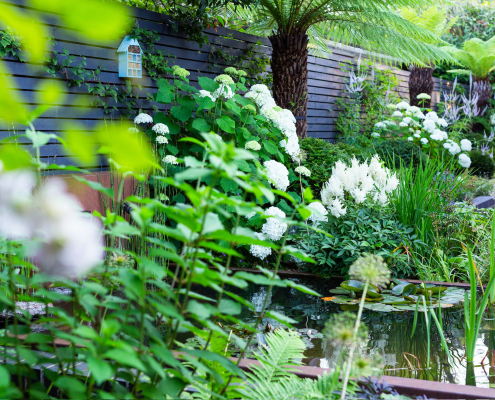Our Top 5 Recommendations to Improve your Small Garden’s Design
Every project is different when designing a garden. Starting a design project for a small garden can be an exciting journey. Just because the space is limited, it doesn’t mean it can’t be impactful. Here are some helpful tips to guide you on where to begin:
Step 1. Identify the space
Start by understanding the unique features of your garden space. Take note of boundaries, existing structures, and any standout elements that can influence your design. Embrace these characteristics and let them influence your design decisions. Work with the site conditions, not against them.

Step 2. Improve the boundaries
Focus on maximising the potential of your boundaries. If there is a lovely old wall, enhance it. Utilise vertical surfaces for planting climbers such as Trachelospermum jasminoides on a sunny wall or fence for the beautiful scent. Wall shrubs, and training fruit as a fan or espalier form. This not only adds greenery and maximises your growing space, but also creates a sense of enclosure and depth in your small garden design, view our previous designs here.
Consider incorporating architectural elements like timber panels or water features to enhance the boundary’s visual appeal and create focal points within the space. Painting rendered walls or timber fences can drastically alter the ambience of the space. White render can be quite cold, painting with warmer colour tones can help to bring warmth on a cold, dank winters day. Be bold with your colour choices. Staining a fence or timber panel black makes the boundary recede, resulting in the illusion that the space is bigger. Black or dark blues and greys are a fantastic contrast for foliage making plants pop against a fence
Step 3. Create layers and depth
Create depth and visual interest in your garden by incorporating layers of planting. Choose plants that flower at different times of the year to ensure year-round interest. Use a variety of heights within the planting, to include small trees and shrubs, taller or mid-height perennials with ground covering species for a rich tapestry of colours and textures. Keep the plant selection simple to avoid overcrowding in a small space. Use repetition within the planting to create cohesion.

Step 4. Consider privacy
Address privacy concerns by strategically placing tall plants, small trees, or trellises to create screening. This helps block unwanted views and enhances the feeling of seclusion in your garden. Consider using narrow plants like bamboos or clump-forming varieties for effective screening in a small space. See my previous blog on tree planting.
Step 5. Surfacing and Courtyard
Create a well-balanced design by incorporating a mix of planting and hardscaping elements. Consider using small paving units like bricks or setts to make the space feel larger. Aim for a courtyard design with a central entertaining area surrounded by well-planned boundaries with visual interest. Maintain a good balance between planting and hardscaping elements, aiming for at least 40% planting in the overall design. Where planting borders are positioned be bad, avoid narrow awkward planting areas, which are difficult to create a well balanced and structured parting scheme.

By starting with these design principles, you can lay a strong foundation for creating a beautiful and functional small garden. Remember to embrace the unique character of your space, maximise boundaries, layer your planting, address privacy concerns, and choose sustainable surfacing materials. Enjoy the process of transforming your small garden into a peaceful sanctuary where every element plays a vital role in the overall design. If you are interested in our design services don’t hesitate to get in touch.
Click here to see more images on the website. Contact us now 07834 233 343, we can assist you with your garden design, jenny@noscoegardendesign.com









